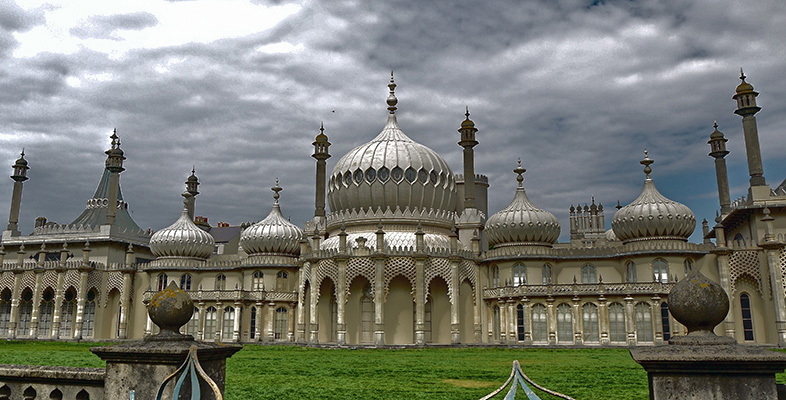Acknowledgements
This unit was written by Dr Nicola Watson
Except for third party materials and otherwise stated (see terms and conditions [Tip: hold Ctrl and click a link to open it in a new tab. (Hide tip)] ), this content is made available under a Creative Commons Attribution-NonCommercial-ShareAlike 4.0 Licence
Grateful acknowledgement is made to the following sources for permission to reproduce material in this unit:
Plate 1 The west front of the Royal Pavilion, Brighton, from John Nash's "Views of the Roayl Pavilion, Brighton", 1826, aquatint. Photo: RIBA Library Photographs Collection
Plate 2 The east front of the Royal Pavilion, Brighton, from JohnNash's "Views of the Royal Pavilion, brighton", 1826, aquatint. Phot: RIBA Library Photographs Collection
Plate 3 The Octagon Hall (designed by Frederick Crace), from John Nash's "Views of the Royal Pavilion, Brighton", 1826, aquatint. Photo: RIBA Library Photographs Collection
Plate 4 The Entrance Hall (designed by Frederick Crace), from John Nash's "views of the Royal Pavilion, Brighton, 1826, aquatint. Photo: RIBA Library Photographs Collection
Plate 5 The Long Gallery (designed by Frederick Crace), from John Nash's "views of the Royal Pavilion, Brighton, 1826, aquatint. Photo: RIBA Library Photographs Collection
Plate 6 The Saloon (designed by Frederick Crace), from John Nash's "views of the Royal Pavilion, Brighton, 1826, aquatint. Photo: RIBA Library Photographs Collection
Plate 7 The Banqueting Room Gallery (designed by Frederick Crace), from John Nash's "views of the Royal Pavilion, Brighton, 1826, aquatint. Photo: RIBA Library Photographs Collection
Plate 8 The Banqueting Room (designed by Robert Jones), from John Nash's "views of the Royal Pavilion, Brighton, 1826, aquatint. Photo: RIBA Library Photographs Collection
Plate 9 The Saloon (designed by Robert Jones), from John Nash's "views of the Royal Pavilion, Brighton, 1826, aquatint. Photo: RIBA Library Photographs Collection
Plate 10 The Music Room Gallery (designed by Frederick Crace), from John Nash's "views of the Royal Pavilion, Brighton, 1826, aquatint. Photo: RIBA Library Photographs Collection
Plate 11 The Music Room (designed by Frederick Crace), from John Nash's "views of the Royal Pavilion, Brighton, 1826, aquatint. Photo: RIBA Library Photographs Collection
Plate 12 Jacob Spornberg, "The Pavilion and the Steine", 1796,. Photo: courtesy of the Royal Pavilion, Libraries and Museums, Brighton and Hove
Plate 13 Thomas Rowlandson, "The Saloon, Marine Pavilion", c. 1789, watercolour, 22 x 29.4 cm. Photo: courtesy of the Royal Pavilion, Libraries and Museums, Brighton and Hove
Plate 14 William Porden, "Design for a Proposed Chinese Exterior", 1805, watercolour. Photo: coutesy of the Royal Pavilion, Libraries and Museums, Brighton and Hove
Plate 15 Thomas Daniell, "The Jami' Masjid, Delhi", plate XXIII from T. and W. Daniell, "Oriental Scenery", 1797, coloured aquatint, private collection. Photo: The Stapleton Collection/ Bridgeman Art Library
Plate 19 Lacock Abbey, Wiltshire.Photo: reproduced by kind permission of Provincial Pictures, Bath. Photographer: Philip Pierce.
Plate 20 Cross-section of the Royal Pavilion, from John Nash's "View's of the Royal Pavilion, Brighton", 1826, aquatint. Photo: RIBA Library Photographs Collection.
Plate 21 George Cruikshank after Alfred Forrester, "The Beauties of Brighton", 1826, hand-coloured engraving. Photo: courtesy of the Royal Pavilion, Libraries and Museums, Brighton and Hove
Plate 22 George Cruikshank, "The Court at Brighton a la Chinese!!", 186, hand-coloured engraving, British Library, London. Photo: Bridgeman Art Library
Plate 23 Artist uncertain, possibly W. Heath, "New Baubles for the Chinese Temple", 1820, hand-coloured engraving. Photo: courtesy of the Royal Pavilion, Libraries and Museums, Brighton and Hove
Figure 1 Modern ground-floor plan of the Royal Pavilion, Brighton. Adapted from Jessica M.F. Rutherford, "The Royal Pavilion", 1995, courtesy of the Royal Pavilion, Libraries and Museums, Brighton and Hove
Figure 2 Sir Thomas Lawrence, "George IV as Prince Regent", c.1814, oil on canvas, 91.4 x 71.1 cm, National Portrait Galery, London. Photo © National Portrait Gallery, London, www.npg.org.uk
Figure 3 Anonymous (probably Henry Kingsbury), "The Prodigal Son", 1787, drawing. Photo: courtesy of the Royal Pavilion, Libraries and Museums, Brighton and Hove
Figure 4 Map of Brightelmstone, frontispiece from H.R.Attree, "Topography of Brighton: and Picture of the Roads, from Thence to the Metropolis", London, 1809. Photo: Bodleian Library, University of Oxford (G.A.Sussex 8 22)
Figure 5 Anonymous, "Love's Last Shift", published 1787 by S.W.Fores, London. Photo: courtesy of the Royal Pavilion, Libraries and Museum, Brighton and Hove
Figure 6 Samuel H.Grimm, "The Prince of Wales' Pavilion at Brighthelmstone, from the Steyne", 1787, British Library, London. Photo: The British Library, London
Figure 7 Plan of the ground floor of the Marine Pavilion, as built by Henry Holland, 1796, engraved and published by G.Richardson and Son. Photo: courtesy of the Royal pavilion, Libraries and Museums, Brighton and Hove
Figure 8 J.Barlow, after Thomas Sheraton, "A View of the Prince of Wales's Chinese Drawing Room", 1792, engraving from Thomas Sheraton, "Cabinet Maker & Upholsterer's Drawing Book", British Library, London. Photo: The British Library, London (shelfmark 61.e.22)
Figure 9 Anonymous, "The Gallery at Strawberry Hill", engraving from Horace Walpole, "A Description of the Villa of Mr H. Walpole at Strawberry Hill", 1784, British Library, London. Photo: The British Library, London (shelfmark 192.c.16)
Figure 10 John Martin, "Sezincote", 1817, aquatint drawn and etched. Photo: courtesy of the Royal Pavilion, Libraries and Museums, Brighton and Hove
Figure 11 John Martin, "Sezincote, Gloucestershire: The Temple Pool", 1817, print, British Museum, London. Photo: by courtesy of the Trustees of the British Museum
mezzoblue / Dave Shea: Flickr
Don't miss out:
If reading this text has inspired you to learn more, you may be interested in joining the millions of people who discover our free learning resources and qualifications by visiting The Open University - www.open.edu/ openlearn/ free-courses
